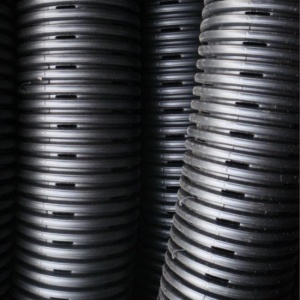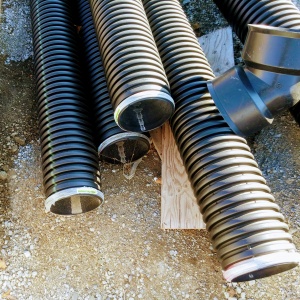Clean out spacingCite error: Closing </ref> missing for <ref> tag[1][2] in relation to loamy or clayey native soils, where Kmedia>>Ksoil, finds the first term of the numerator negligible, so that the original equation:
 may be simplified to:
may be simplified to:

Where:
- Kmedia is expressed in m/day
- Dd is the depth to the drain pipe (m)
- Dw is the minimum acceptable depth to the water table during infiltration event
- q is the inflow volume expressed as a depth over the entire surface (m)
Example[edit]
During a 25 mm storm event, a bioretention cell receives concentrated flow from a catchment 20 times larger than its own footprint (25 x 20 = 500 mm = 0.5 m).
The bioretention cell comprises 0.6 m filter media (K = 2.4 m/day), laid over 0.6 m clear, coarse reservoir gravel. The pipes are laid within the reservoir, 0.9 m below the surface.
The system is designed to fill entirely during the rainstorm event. i.e. Depth to water table = 0 m.:

Underdrains for non-exfiltrating practices[edit]
Below ground[edit]
Where a stormwater planter or biofiltration cell is contained within a concrete box or completely lined to prevent infiltration, the perforated pipe should be bedded on a thin layer of fine aggregate. This thin layer is to hold the pipe in place during construction, and to permit free ingress of accumulated water through holes on the underside of the pipe. As storage in a non-infiltrating practice is predominantly through soil/water tension, the depth of reservoir should be minimised to just accommodate the pipe.
A pair of vertical clean out pipes/wells should be included in the design, for inspection and periodic flushing of accumulated sediment. As most hydro-jetting apparatus used for this has some trouble accommodating narrow 90 deg bends, it is important that both ends of a perforated pipe be connected with a pair of 45 deg elbows/Y connectors instead.
Above ground[edit]
Where possible the underdrain pipe should be designed without any bends in order to facilitate easy maintenance. Otherwise see advice above regarding connectors.
- To promote infiltration the base of the gravel reservoir and the underdrain pipe should be horizontal to optimize distribution of the water within.
- Where drainage or conveyance to a downstream facility is a greater priority, the base of the reservoir and the underdrain pipe may have a gradient of up to 1-2%.
Maintenance and inspection[edit]
- Wells, of 100 - 150 mm diameter perforated pipe, should extend to the bottom of the facility.
- The exposed tops of all wells should be fitted with lockable caps.
Material specifications[edit]
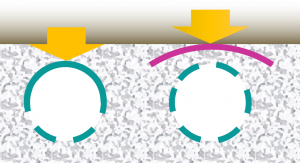
Pipes are available with perforations on just one side, these should be situated on the lower half of the pipe. Pipes with 360° perforations should have a strip of
geotextile or membrane placed over the pipe to reduce the migration of
fines from overlying media.
Perforated pipes are a common component of underdrains used in bioretention, permeable pavements, infiltration trenches and exfiltration systems.
Pipes should be manufactured in conformity with the latest standards by the Canadian Standards Association (CSA) or ASTM International.
- Perforated pipes should be continuously perforated, smooth interior HDPE or PVC.
- Wherever possible pipes should be ≥200 mm internal diameter to reduce potential of freezing and to facilitate push camera inspections and cleaning with jet nozzle equipment.
- Smooth interior facilitates inspection and maintenance activities; internal corrugations can cause cameras or hydrojetting apparatus to become snagged.
- A perforated pipe with many rectangular slots has better drainage characteristics than a pipe with similar open area provided by fewer circular holes [3].
- Non-perforated pipes should be used for conveyance of stormwater to and from the facility, including overflow. It is good practice to extend the solid pipe approximately 300 mm within the reservoir or practice to reduce the potential for native soil migration into the pipe.
Pipe with slotted perforations
Perforated pipes awaiting installation, note the 45 degree couplings used to facilitate push camera inspection and jet nozzle cleaning.
See also: Flow through perforated pipe
Reservoir gravel[edit]
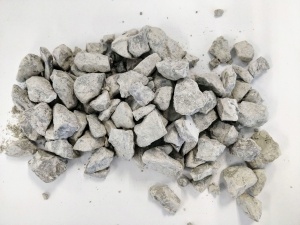
Note the uniform size and angularity of this clear stone sample. Note also that the fragments all appear to have a film of fine particles adhering; this material would be improved by being washed prior to use.
This article gives recommendations for aggregate to be used to store water for infiltration. This is usually called 'clear stone' at aggregate yards.
To see an analysis of Ontario Standard Specifications for granular materials, see OPSS aggregates.
For advice on decorative surface aggregates see Stone
Gravel used for underdrains in bioretention, infiltration trenches and chambers, and exfiltration trenches should be 20 or 50 mm, uniformly-graded, clean (maximum wash loss of 0.5%), crushed angular stone that has a porosity of 0.4[4].
The clean wash to prevent rapid accumulation of fines from the aggregate particles in the base of the reservoir. The uniform grading and the angularity are important to maintain pore throats and clear voids between particles. (i.e. achieve the porosity). Porosity and permeability are directly influenced by the size, gradation and angularity of the particles [5]. See jar test for on-site verification testing protocols.
Gravel with structural requirements should also meet the following criteria:
- Minimum durability index of 35
- Maximum abrasion of 10% for 100 revolutions and maximum of 50% for 500 revolutions
Standard specifications for the gradation of aggregates are maintained by ASTM D2940
The highest porosity is found in uniformly graded aggregate, as there are no smaller particles to occupy the inter-particle pores. [5]
Higher permeability is found in larger, angular, uniformly graded aggregate. This is due to larger pore sizes and lower tortuosity. [5]
Choker course[edit]
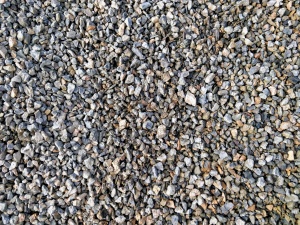
medium sized
granular, free from
finesIn bioretention systems a choker layer of ≥ 100 mm depth is the recommended method to prevent migration of finer filter media into the underlying storage reservoir aggregate.
These same mid-sized granular materials are recommended for use in Stormwater planter underdrains and may be useful in the fine grading of foundations courses for permeable pavements.
Suitable materials include:
- High performance bedding (HPB)
- Clean, angular aggregate screened to between 6 and 10 mm. Widely available and designed specifically for drainage applications. Free from fines by definition.
- HL 6
- Is a clean, angular aggregate screened between 10 and 20 mm. Free from fines by definition.
- Pea Gravel
- Rounded natural aggregate, screened between 5 and 15 mm, and washed free from fines.
In most scenarios, a geotextile layer is unnecessary and has been associated with rapid decline and clogging in some circumstances.
Geotextiles[edit]

The properties of geotextiles vary widely.
See Clogging for notes on their application in LID structures.
Geotextiles can be used to prevent downward migration of smaller particles in to larger aggregates, and slump of heavier particles into finer underlying courses. Geotextiles are commonly used on low strength soils (CBR<4).
The formation of biofilm on geotextiles has also been shown to improve water quality:
- By degrading petroleum hydrocarbons[6]
- By reducing organic pollutant and nutrient concentrations [7]
- When installing geotextiles an overlap of 150 - 300 mm should be used.
Material specifications should conform to OPSS 1860 for Class II geotextile fabrics
[8]. Note when expansive clays are present, a non-infiltrating design may be necessary. If used, geotextile socks around perforated pipes should conform to ASTM D6707 with minimum water flow rate conforming to ASTM D4491 (12,263 L/min/m2 at 5 cm head).
- Fabrics should be woven monofilament or non-woven needle punched.
- Woven slit film and non-woven heat bonded fabrics should not be used, as they are prone to clogging.
In choosing a product, consider:
- The maximum forces that will be exerted on the fabric (i.e., what tensile, tear and puncture strength ratings are required?),
- The load bearing ratio of the underlying native soil (i.e. is the geotextile needed to prevent downward migration of aggregate into the native soil?),
- The texture (i.e., grain size distribution) of the overlying and underlying materials, and
- The suitable apparent opening size (AOS) for non-woven fabrics, or percent open area (POA) for woven fabrics, to maintain water flow even with sediment and microbial film build-up.
Recommended criteria for selection of geotextile fabric
| Percent soil/filter media passing 0.075 mm (#200 sieve)
|
Non-woven fabric apparent opening size (AOS, mm)
|
Woven fabric percent open area (POA, %)
|
Permittivity (sec-1)
|
| >85 |
≤ 0.3 |
- |
0.1
|
| 50 - 85 |
≤ 0.3 |
≥ 4 |
0.1
|
| 15 - 50 |
≤ 0.6 |
≥ 4 |
0.2
|
| 5 - 15 |
≤ 0.6 |
≥ 4 |
0.5
|
| ≤ 5 |
≤ 0.6 |
≥ 10 |
0.5
|
Performance research[edit]
http://www.mdpi.com/2073-4441/7/4/1595/htm
Alternative Technology[edit]
Smart drain is a polymer ribbon-like material with capillary drains on the underside; it's use has recently been demonstrated in bioretention[9]. It's low profile may make it particularly well suited to non-infiltrating practices, such as Stormwater planters.
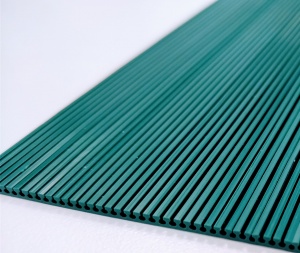
Ribbon-like drainage material




